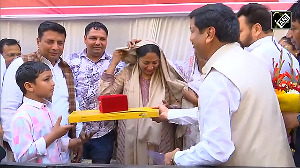The proposed laboratory building on the 25 acre campus is a ground plus three floors structure set on the southern edge of a large central maidan. But instead of a closed-in structure, with a clear demarcation between surrounding landscape and built area, what Anupam Bansal and Rajesh Dongre of 10-year-old Delhi firm ABRD Architects have done is open out the building to the surrounding greens, allowing it to flow in and over.
A smooth green lawn covers the auditorium which forms the first block of the building on the ground floor and is half sunk below ground-level, continuing past and above it to form a promenade in front of the main laboratory building behind.
The intent was to come up with an "architecture that enhances creativity", and the architects visited many celebrated laboratory buildings in the US like the Salk Institute campus in California (designed by Louis Kahn) and the Clarke Centre at Stanford, scouting for ideas. Elements from many of these buildings have been incorporated into the design.
For example, openness - a large part of the facade is glass, so you can look out and into the laboratories, classroom, libraries; the same vocabulary of openness also finds expression in the open pipes, ducts, cables.
Then there is flexibility of work space, with an open plan lab and common area for resources, and separation of service areas with service shafts between floors so maintenance and changes can be made without disturbing the scientists at work.
The duo, which won the project through an invited competition last December, has also incorporated a number of green building features. Most important of these is landscaping; but the air-conditioning load is further minimised by the use of double-glazed glass and the north-south alignment of the building.
Also, the building has been organised so as to cause minimal disruption to the existing structures. Bansal and Dongre also plan to put in solar panels for water heating and lighting of the service areas; in addition to recycling water for non-potable use, and using locally available building materials.
In this, the architects are carrying forward some of their practices from a recent project, the head office of Spectral Services Consultants in Noida which is a platinum rated LEED certified green building.
Here too Bansal and Dongre integrate eco-friendliness with design aesthetics, so you have a roof-lit atrium with louvres that not just lights up the interiors but also gives it grandeur; vertical fins to cut out the light but let in the air, making the structure quite a showpiece to the green tenets of Prem Jain, the chairman of Spectral Services who is also president of the Delhi chapter of the Indian Green Building Council.
While energy efficiency is a recent focus at ABRD, landscaping is a more long-standing one. Look at one of its earlier buildings - the Alliance Francaise in Delhi, to note how the flora is made an integral part of the structure. Indeed, Dongre, who worked on the India Habitat Centre building nearby during a short stint at Stein, Doshi & Bhalla, says it was a challenge designing a structure in "Steinabad".
Located close to the Lodi Gardens, the Alliance Francais centre blends seamlessly into the dominant architectural tone of the area - a mix of institutional grandness and Lutyens's concept of "garden city".
Says Dongre, "The building is designed around 17 trees that were present on the site." Adds Bansal, "Of course, the success of the Alliance structure also lies in the way it is used. We designed it as an open building with access from two sides, and it is good to see that it is being used as such. The LIC Building Charles Correa designed was also meant to be free to the public. But look at it now."
The duo has another interest - adaptive re-use, and there's no better illustration of this than their office in Khirkee village. It is an 80-90 year old village house and still retains much of its original character. Bansal and Dongre have made a few changes, but these are more in the way of strengthening it and getting rid of extraneous later-day additions than adding modern touches.
"There was a toilet here," says Bansal, pointing to the red stone sitout, "which was obstructing the view of the impressive main door." The niches, the roof with their wooden rafters and the red-cement floor, even the khatia on the roof add a pleasantly quaint touch to the otherwise conventional busy architects office, without taking away from its functionality.
Similar principles have been used in two other projects - the LDAV college in Bulandshahr where Bansal and Dongre restored a 1913 brick barracks for use as a college, and the Gole Market restoration project (stuck on account of protests by shopkeepers) on which they associated with conservation architect and SPA classmate, Abha Narain Lamba. "The idea behind such projects is to revitalise a dead space and to convert it into an active space."
That could well be the credo of all sensible, sensitive architecture.







 © 2025
© 2025